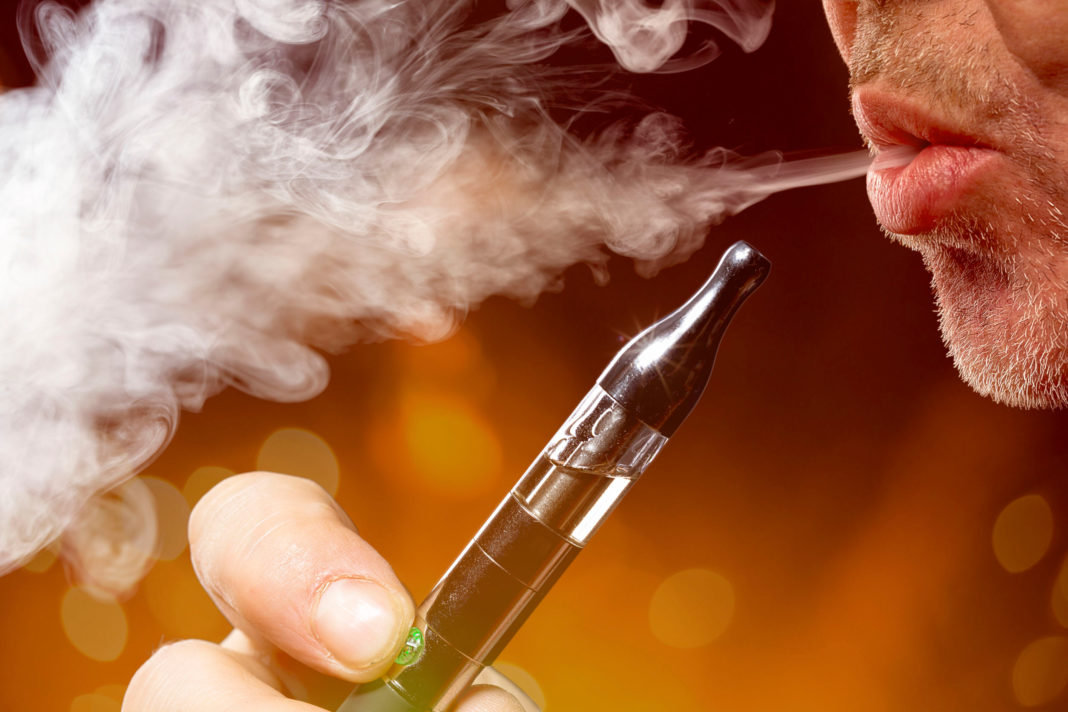Continuing our look into the prevalence of vaping amongst young people, in Part 2 of ‘Curiosity, peer pressure and nicotine: why young people are choosing to vape’, we speak with a number of area schools to gauge their stance on the issue, look at the increase in littering on our streets as a result of vaping, and speak with some more students who outline their views.
SCHOOLS
“We take a hard line. First and foremost, it’s policy, it’s national law and we don’t allow it. They’ve replaced smoking with vaping as the new ‘cool’. Our two biggest problems are the size of the units, and their availability.” This is according to principal of Scoil Pól, Kilfinane, Mike O’Hara, who ‘hates’ vaping.
As outlined in Part 1 last week, availability of vape products is a big issue with no regulation currently on who can buy them.
“They’re not illegal for under 18s and no matter what they say, they’re targeted at them, and I would say even down to as young as 10. The education we provide in the school is constant; through SPHE (Social, Personal, and Health Education) but also general conversation, through pastoral care and through year heads.
“We educate specifically on the health aspect but also on the peer pressure element. Teenagers and kids will follow trends – they’re not going to check if it’s safe or whatever. The responsibility lies with the adults, and education has to come from the home too. There isn’t enough education about them.”
‘THE WORK ON VAPING HAS TO START’
With many vapes, particularly the disposable ones, slightly shorter in size than a highlighter pen, they are easy for users to conceal in their hand, allowing them to be used easily almost anywhere, with anyone trying to enforce a ban tasked with a difficult job.
Mr O’Hara reiterates that his school takes a very firm line on vaping, and particularly as a gateway to smoking cigarettes.
“I don’t like it. I think there is an insidious side to it that the government are not taking seriously. Schools have done tremendous work on reducing the number of kids smoking, and the work on vaping has to start”.
Elsewhere, CBS Secondary School in Mitchelstown confirmed to The Avondhu that vaping is included as part of the school’s anti-smoking policy, and is covered in the school’s SPHE programme.
One staff member said that, although she couldn’t speak for everyone, she had never witnessed vaping on the school grounds.
In nearby Presentation Secondary School, a spokesman said that the school had a strict policy in force.
“The school has a strict no smoking and no vaping policy. The effects of smoking and vaping are discussed during SPHE lessons, for example, what’s contained in each, the health effects, et cetera.”
REGULATION
The move to regulate e-cigarette use has been underway for some time and in November 2022, the Government approved a ban on the sale of e-cigarettes to minors after proposals were brought to the Cabinet.
Under the new proposals, the sale of nicotine-inhaling products are prohibited from vending machines, from temporary premises and at places or events for children, while advertisements for e-cigarettes are also prohibited on public transport, in cinemas and near schools.
In December, Cork North Central TD, Colm Burke raised concerns regarding e-cigarette use among adolescents, questioning the Minister for Health on the matter during a Dáil debate.
Citing the Public Health (Tobacco and Nicotine Inhaling Products) Bill 2019, Minister for Health, Stephen Donnelly, said: “These measures together are aimed at reducing the availability of e-cigarettes to young people and their usage by young people”.
Early November also saw Deputy Burke host an event titled ‘Tobacco 21: The case for raising the legal age for the sale of tobacco and e-cigarettes in Ireland’, which called for the age of product purchases to rise from 18 to 21 years old.
LIKELY TO LEAD TO SMOKING
Research undertaken by The European Respiratory Journal (ERJ), titled ‘Increased smoking and e-cigarette use among Irish teenagers: A new threat to Tobacco Free Ireland 2025’ (ii), found ‘a negative effect of e-cigarette ever-use on teenagers’ likelihood of current smoking’.
It stated: ‘When the model controlled for various factors associated with smoking, e-cigarette ever-use had an additional negative effect, increasing the risks of being a current smoker for both boys and girls. E-cigarette current-use also increased the risk for current smoking for both boys and girls.
‘Our findings support the need for the extension of tobacco control legislation regarding minors to include e-cigarettes. This may be desirable to prevent exposure to second-hand aerosol (SHA) (11) but also because of the possible renormalisation of smoking (9).’
‘MOST OF IT IS FOR IMAGE’
‘Curiosity’ is cited as a significant factor for youngsters to vape, according to Loreto Secondary School student, Leah Nolan. Her award winning study in the recent BT Young Scientist and Technology Exhibition, ‘Vaping Under The Influence: An investigation into the impact of social media on adolescent attitudes towards vaping’, highlighted the fact.
She also found a statistically significant correlation between influencers vaping or speaking about vaping online and adolescents subsequently vaping. However, she states that this is not the only contributing factor to the culture of underage vaping.
“Overall, I found that social media does influence an adolescent’s decision to vape, whether it be for the first time or further use.
“One thing I know from the project is that it’s unlikely that social media would be a factor on its own, it’s likely a contributing factor to an adolescent’s decision to vape. Especially considering the most common reason people gave for vaping was curiosity. It would be one of the many factors that would go into an adolescent’s decision to vape,” she told The Avondhu.
PASSING THEM AROUND ‘VERY NORMAL’
One secondary school student from Fermoy The Avondhu spoke with, said that she thought the dangers of vaping were not sufficiently advertised. That said, she said of people who vape that “they have common sense; they know it’s not going to be any good”.
“It’s so normal, and so accessible. People that I would never have thought of, are now vaping. It is a cool image, and passing them around (from person to person) is really very normal. Most of it is for image”.
The school toilet, she claimed, is a popular spot to vape.
Another student who attends the same school said that when she goes into the bathroom, she’s met with ‘clouds of strawberry smoke’. However, it was noted that teachers do spot-checks, with suspensions handed out to anybody found to be breaking the school’s no smoking policy.
Furthermore, the student said that she’s aware of the health implications of vaping through a conversation her parents had with her about smoking, although it wasn’t touched on directly.
The solution, she suggests, is for authorities to do more research on vapes and to print graphic images on the boxes themselves, as they do cigarettes.
FREE DEVICE RECYCLING
As disposable, single-use, rechargeable vape and/or e-cigarette devices can contain batteries, they are classed as EEE products (Electronic and Electrical Equipment) – which should be recycled when they reach the end of life. Disposable vapes contain a number of valuable materials such as lithium batteries and copper, as well as plastic, all recyclable.
According to WEEE Ireland, retailers are obliged to take back disposable, single-use, rechargeable vape and/or e-cigarette devices on a one-for-one, like-for-like basis in-store or on delivery – and should highlight the fact in-store and/or online.
WEEE Ireland facilitates the collective take back of this e-waste for free recycling via their Blue Battery Box System.
However, the litter created from disposable vapes is unconscionable. There are multiple elements: a cardboard box, a foil wrapper, and the unit itself which is plastic, foam lining, more plastic, and a battery.
Furthermore, as many teenagers will hide the fact that they’re vaping, they’re more likely to dump any evidence of use before they get home, out of necessity. While this is no problem if bins are used, going on the evidence of items discarded on many streets locally, packaging items from disposable vapes are clearly strewn around.
In the UK, research commissioned by Material Focus (i) and carried out as part of an investigation with the Bureau of Investigative Journalism in 2022, identified that 1.3 million single-use vapes were being thrown away every week, per annum – enough to cover 22 football pitches.
The research also identified ‘that single use vapes are particularly problematic with nearly 14 million single-use vapes bought each month, rising to 167.5 million a year’.
Over 50% of single-use vapes are thrown away according to the survey, compared to 33% on average for all types of vapes. The survey also found that about a quarter (23%) recycle their vapes in store when they buy new ones; and one-fifth (20%) recycle their vapes at a local authority recycling centre
Consider that the lithium batteries – a finite material that rechargeable technology relies on – ‘in these vapes alone equate to 10 tonnes of lithium a year, equivalent to the batteries inside 1,200 electric vehicles.’
One local retailer The Avondhu spoke with, noted a shift from the disposable products to those that contain a unit that’s refillable, but admitted that this is probably financially motivated rather than being based on any environmental concerns from users, as refillable units work out vastly cheaper.
‘NOT BIODEGRADABLE’
Around Fermoy town, regular vape and e-cigarette litter has been noted in a number of locations and has been proving an issue for Fermoy Tidy Towns.
Paul Kavanagh of Fermoy Tidy Towns noted that initially, it was the cardboard packaging that volunteers noticed. However in recent times, the single-use or disposable cartridges have been creating a new problem.
“We’re now discovering the cartridges that are ‘disposable’. The issue here is that they are not actually disposable, they’re not biodegradable, they won’t disintegrate,” he said.
LITTER IS ‘BECOMING A SCOURGE’
Speaking with The Avondhu, one local suggested that shops and traders selling e-cigarette products locally should offer to take the outer cardboard packaging when selling these products, to avoid the resultant litter around the streets.
In the past, cigarette butts made up a large proportion of the town’s litter according to the local volunteer group, and while this issue persists, Mr Kavanagh notes that the situation with cigarette butts is improving and that due to the longer use-time of vapes and e-cigarettes, the level of associated litter is not noted as being the same – at present at least – as that from traditional cigarettes.
“(The litter) wouldn’t be to the same level, but we are saying that they need to be disposed of properly. Put them in the bin. When they run out, people seem to just throw them wherever. They’re not biodegradable and they’re now becoming a scourge,” Mr Kavanagh said.
HABIT
Speaking with college students doing their placement at Teagasc, Moorepark, the reasons for going outside for a vape are a tale as old as time – ‘because everyone else is’. It’s habit, it’s just ‘something you do’.
Adults however, surely have to play a more proactive role in educating youngsters on the issues outlined in this series, surrounding vaping.
SOURCES
Increased smoking and e-cigarette use among Irish teenagers: A new threat to Tobacco Free Ireland 2025
Salome Sunday, Joan Hanafin, Luke Clancy, ERJ Open










